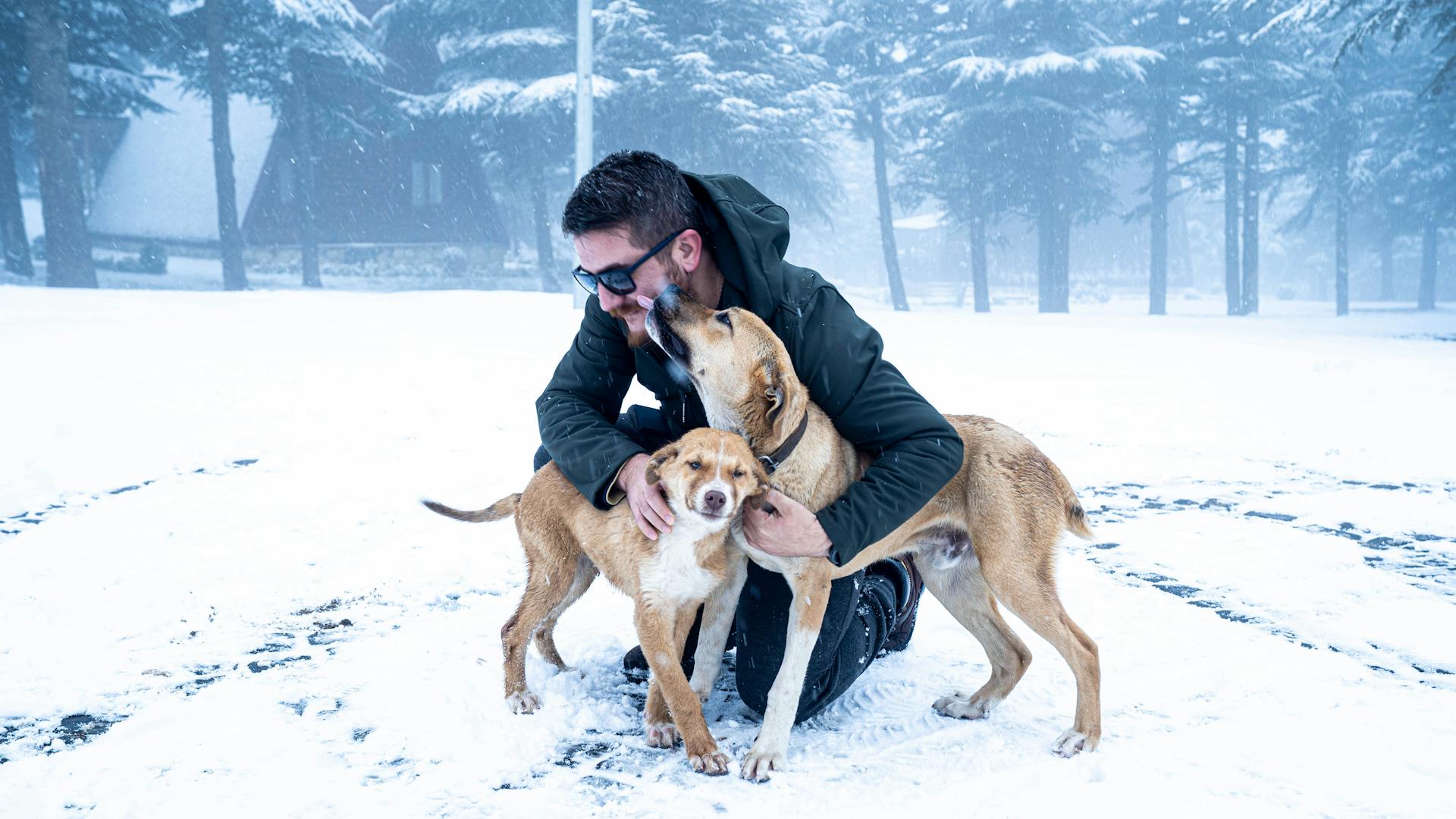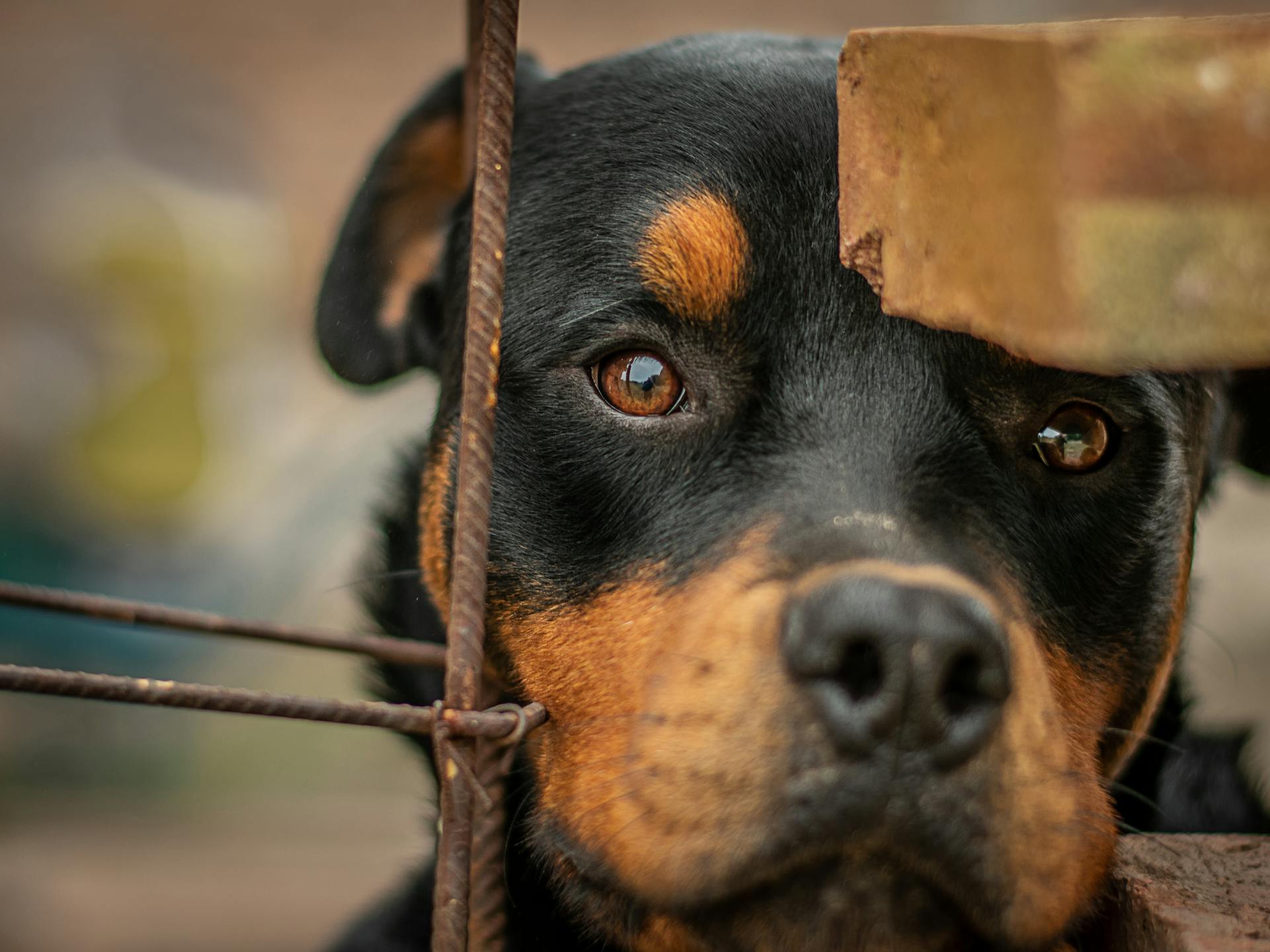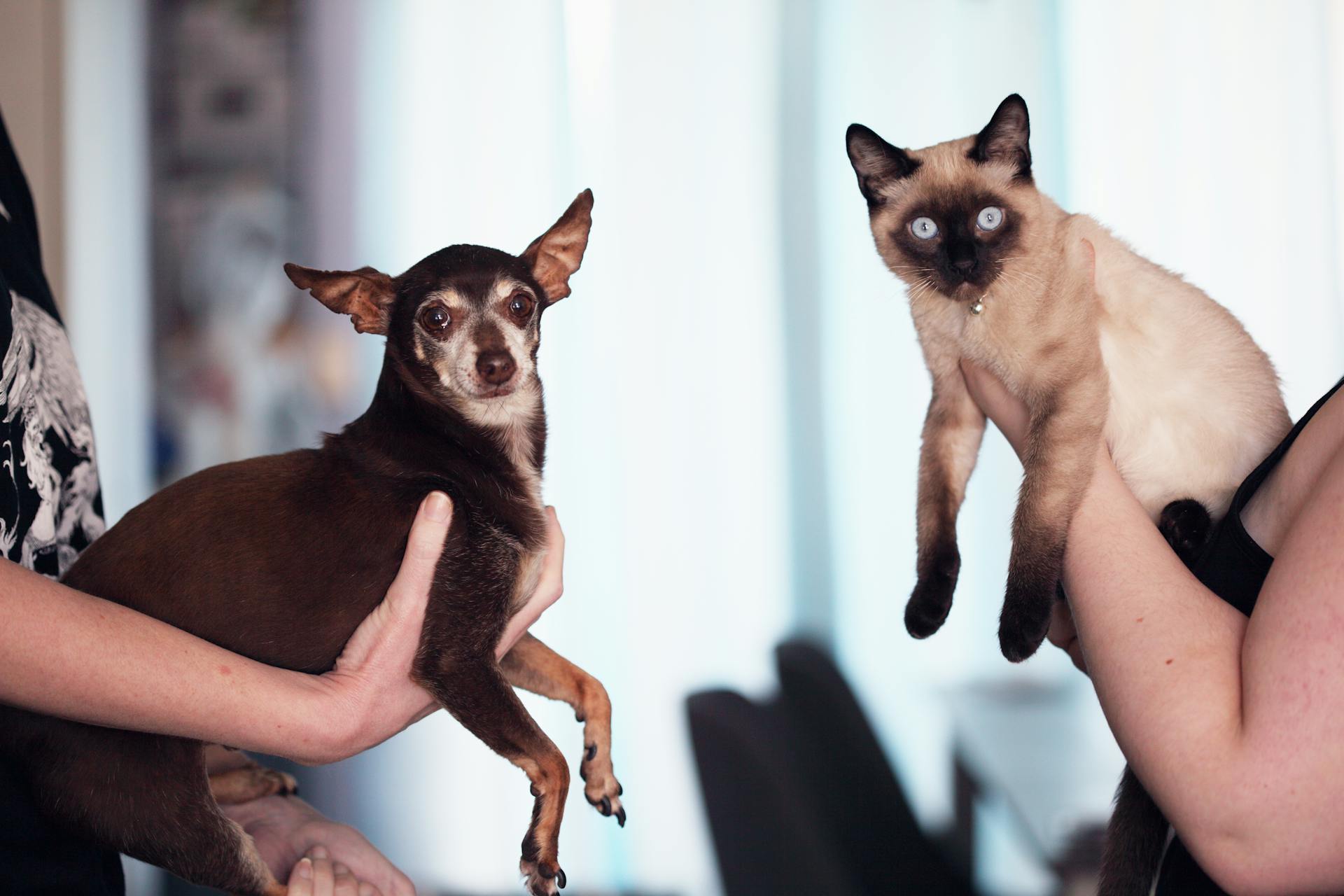
Getting two male dogs to get along can be a challenge, but with patience and consistency, it's achievable.
Introducing them to each other gradually is key, as mentioned in the article. This helps prevent territorial behavior and allows them to become familiar with each other's scents and sounds.
Start by keeping them separated and allowing them to sniff each other through a barrier, such as a baby gate.
This allows them to become comfortable with each other's presence without feeling threatened.
Readers also liked: When Do Male Dogs Start Producing Sperm
Why They Fight
Dogs from the same household fight over resources like toys, food, treats, or cuddles from their favorite people, just like human siblings. This is especially true if they are of the same sex and one of them is sexually maturing.
Stress is the number one reason why dogs attack each other in the house. With the rare exception of idiopathic aggression, aggression is the result of a stress load that pushes a dog over his bite threshold.
Dogs can be notoriously stoic about pain, especially slowly developing arthritis, or unilateral pain, which can be a trigger for aggression. The undiagnosed arthritic dog may become defensively aggressive in anticipation of being hurt by a livelier canine pal.
Resource guarding is a common trigger for aggression, where one dog guards a valuable resource like a chew item or a spot on the sofa. The stressor in these cases is obvious: the dog is anxious over the possibility of losing or having to share his treasured possession.
Here are some common stressors that can contribute to aggression in dogs:
- Tension over resources
- Hormonal changes, especially during sexual maturation
- Pain or discomfort, often due to undiagnosed arthritis or other medical issues
- Stressful environments, such as changes in exercise opportunities or human family members' stress levels
By identifying and addressing these stressors, you can reduce the likelihood of your dogs fighting and create a more harmonious household.
Introduction Techniques
To get two male dogs to get along, you need to start with a neutral territory introduction. This means choosing a place that's new to both dogs, so neither feels the need to defend their space.
A neutral territory introduction reduces initial tension by allowing the dogs to get accustomed to each other's presence without forced interaction. Choose a place with minimal distractions, like a quiet park or a fenced area in your backyard.
Start by taking both dogs on a long walk together, side by side, while they're leashed. This helps them get used to each other's presence without feeling anxious or threatened. Keep the leashes loose, as tension on the leash can increase anxiety.
You can also try a slow and calm approach, letting the dogs sniff each other while they're still on the leashes. This allows them to get a sense of each other's scent and body language without feeling overwhelmed.
Creating a Peaceful Environment
Creating a peaceful environment is crucial for getting two male dogs to get along. Designate specific zones in your home as peaceful areas where each dog can relax without being disturbed by the other.
These areas should be separated enough to give each dog a sense of their own territory and consistency is key, so always maintain these consistent, designated peaceful areas in your home. Consistency is important, so always maintain these consistent, designated peaceful areas in your home.
You can also use baby gates or play pens to keep them apart and give each dog their own areas with their own bed, water, and food bowls. This will help reduce tension and promote harmony between the dogs.
Intriguing read: Adorable Home
Creating a Positive Shared Environment
Creating a Positive Shared Environment is all about setting your dogs up for success. Introducing dogs to each other requires careful management of resources, space, and activities.
Designating specific zones in your home as peaceful areas can help each dog relax without being disturbed by the other. These areas should be separated enough to give each dog a sense of their own territory.
Creating a stress-free environment is crucial for introducing dogs to each other. A stress-free walk can help calm them down before allowing them to meet while leashed in a controlled environment.
Supervising interactions between dogs is essential, especially when introducing a puppy to an older dog. You should be prepared to intervene if play turns to aggression.
Exercise can be immensely helpful in minimizing overall tension in your dogs' environment. A tired dog is a well-behaved dog, and a happy owner!
Basic training enables you and your dog to communicate more easily with each other, reducing stress for both of you. A good training program emphasizes structure and consistency, making a dog's world more predictable.
Meet Your Experts
Tamsin de la Harpe has nearly two decades of experience with dogs in rescue, training, and behavior modification with fearful and aggressive dogs.
She has worked closely with veterinarians and various kennels, building up extensive medical knowledge and an understanding of canine health and physiology.
Tamsin currently keeps a busy homestead with an assortment of rescue dogs and three Bullmastiffs.
Her extensive experience has given her a unique understanding of how to create a peaceful environment for dogs, taking into account their medical needs and emotional well-being.
Managing Aggression
Intervening early is key to managing aggression between two male dogs.
Supervise interactions closely, looking out for defensive or dominant behaviors. Clear rules and routines can help prevent chaos, especially at dinnertime in a multi-dog household.
To manage doorways and mealtime manners, use body blocks – physical interventions that mimic canine communication methods without contact. This can be an effective way to manage aggression.
Teach your dogs to "wait" individually before exiting doors, and then together. This training installs a level of respect for you and each other, ensuring they don't rush or potentially cause fights.
Identify the immediate trigger for aggression, which is often a resource issue, such as food or a coveted spot on the sofa. Recognize that resources can include more than just food, and that anxiety over losing or sharing can lead to aggression.
Consider using baby gates or play pens to keep your dogs apart, especially if they're new to each other or have a history of fighting.
Manage your dogs' environment to minimize exposure to stressors, such as using doors, fences, baby gates, crates, and tethers to separate them. Smart positioning can also help, by locating each dog's crates or tethering area out of the other dog's sightline.
To reduce tension, take your dogs outdoors to potty separately, and separate them well before feeding time. Minimize their exposure to other stressful stimuli, such as passers-by outside the living room window.
Training and Obedience
Training and obedience are key to getting two male dogs to get along. Focusing on obedience and training provides structure and teaches self-control, enabling them to interact positively.
To start, begin with basic obedience commands like 'sit', 'stay', 'come', 'down', and 'leave it'. These commands are essential for control and as a starting point for other exercises.
The 'sit' command is particularly important, as it's essential for control and helps your dogs understand who's in charge. The 'stay' command encourages self-discipline when there's a need to halt their actions.
The 'come' command ensures your dogs return to you amidst distractions, which is crucial when introducing them to each other. The 'down' command is helpful in calming excitement levels, and the 'leave it' command teaches them to avoid unwanted behaviors or objects.
A predictable schedule is crucial for dogs to coexist calmly. Establish clear routines for walking, eating, and resting times to give your dogs a sense of security and minimize opportunities for conflict.
Here are the basic obedience commands you should start with:
- Sit – Essential for control and as a starting point for other exercises
- Stay – Encourages self-discipline when there’s a need to halt their actions
- Come – Ensures they return to you amidst distractions
- Down – Helpful to calm excitement levels
- Leave it – Teaches them to avoid unwanted behaviors or objects
Training your dogs with positive reinforcement will help to strengthen your bond and make them listen to you more. This is, essentially, the key to success, especially when it comes to getting two male dogs to get along.
Developing a training plan that includes counterconditioning and desensitization will help your dogs feel more comfortable being around each other. Consider consulting a qualified trainer or behaviorist who's dedicated to using positive reinforcement based methods to help with this.
Preventing Conflict
Preventing Conflict is key when it comes to getting two male dogs to get along. Supervising interactions between them is crucial to prevent conflicts from arising.
Managing their environment is also essential to keep them from antagonizing each other. This can be done by providing separate areas for eating, sleeping, and playing.
Resource guarding is a common issue that can lead to conflicts. To prevent this, make sure each dog has their own set of resources, including food and water bowls, and separate beds.
Here are some practical tips to prevent resource guarding:
By following these tips and managing their environment, you can help to prevent conflicts between your two male dogs and create a more harmonious household.
Final Steps
As you've been working on getting your two male dogs to get along, you've likely been focusing on building their bond through play and positive reinforcement.
It's essential to remember that every dog is different, and some may need more time and effort to adjust to each other.
In the early stages, it's crucial to keep interactions between the dogs brief and controlled to prevent any escalation of tension.
By gradually increasing the time and frequency of interactions, you can help them become more comfortable with each other's presence.
Remember to reward calm behavior with treats and praise, as this will help reinforce positive associations between the dogs.
As you continue to progress, be patient and don't rush the process, as rushing can lead to setbacks and reinforce negative behaviors.
In some cases, introducing a neutral third dog can help facilitate a peaceful coexistence between the two males.
With consistency, patience, and positive reinforcement, you can help your two male dogs develop a strong and lasting bond.
Frequently Asked Questions
Is it normal for male dogs to not get along?
Male dogs may not get along due to instinctual behavior, particularly when intact males interact with other dogs. Neutering can help reduce aggression and improve social interactions, but it's not a guarantee against conflicts.
Sources
- https://furbo.com/blog/en/article/10-things-you-can-do-to-get-2-dogs-to-get-along
- https://pawsafe.com/blogs/dog-training/how-to-make-two-dogs-get-along
- https://zigzag.dog/en-us/blog/puppy-behavior/barking-and-aggression/how-to-stop-dogs-from-fighting-in-the-same-household/
- https://www.whole-dog-journal.com/behavior/dog-on-dog-household-aggression/
- https://peachonaleash.com/littermate-syndrome-dogs/
Featured Images: pexels.com


